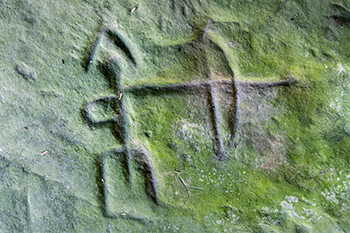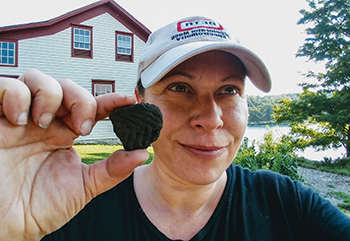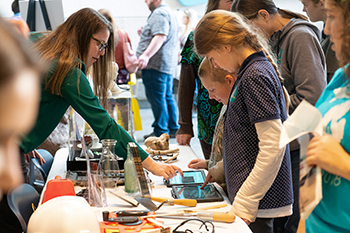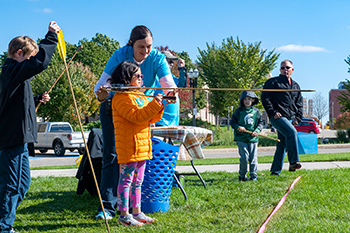Showcasing the DNR
By STACY TCHORZYNSKI
Michigan Department of Natural Resources
Behind the broken plaster and lath, built up between the studs, was a curious cache of items: 13 morphine bottles, glass syringes, lace, a book and more.
We carefully recorded the finds before gently removing them from their hiding place of over a century. I imagined what life was like for the person who hid the items.
In 2000, I was a student in Eastern Michigan University’s Historic Preservation Field School at Fayette Historic State Park in Delta County. Fayette was a bustling 19th-century industrial townsite filled with working families. It is now listed in the National Register of Historic Places and is a world-class regional history attraction.
Among other preservation trade skills, the field school was teaching us plaster repair within a building that would have housed company foremen or managers and their families.

We were working in the walls when the morphine bottles, syringes and other artifacts were discovered. Having had some archaeological training, I was asked to document and collect the finds. This was my first taste of state-land archaeology and historic preservation. I got hooked.
What is archaeology?
Archaeology is the scientific study of the human past, using places and objects to understand changing people and environments. Archaeology shows that people have lived in Michigan for upwards of 14,000 years.
From the earliest evidence documented to date – mammoth and mastodon kill sites – to 20th-century logging camps, shipwrecks and neighborhoods, our ancestors have left traces of their everyday lives across the landscape.
Studying this heritage honors human experience on multiple scales, from the big and collective goings-on, such as community life in an industrial company town like Fayette, to small and sometimes deeply personal events.
Archaeological research celebrates diversity, reveals dynamic social relationships, contributes to environmental planning, supports heritage tourism and helps celebrate and galvanize communities with a shared past.
|

Like many of my colleagues who do history work, I believe that our study of the past can have a real impact on how we understand our present and help us plan the future. Our ancestors are never very far away from our lives and choices today.
Archaeology at the DNR
I was born in Chicago and grew up in Canton, Michigan. After graduate school, a career in cultural resources management stretching from North Dakota to New York and 10 years of service in Michigan’s State Historic Preservation Office, I’m now at home in a department that exists solely to manage – and get people excited about – natural and cultural resources.
I often return to Fayette, now helping manage the history that captured my imagination so many years ago. More broadly, I’m charged with leading the Michigan Department of Natural Resources’ new state archaeology program.
Together with the DNR’s Michigan History Center director Sandra Clark, maritime archaeologist Wayne Lusardi, and many state, federal and tribal partners, I help look after our significant, fragile and often threatened archaeological record.
The DNR oversees approximately 4.6 million acres of public lands, including state forests, wildlife and recreation areas, parks and fisheries. The agency also oversees state-owned antiquities rights statewide on land and underwater.
|

I help manage archaeological data and collections, contribute to land and resource management plans, review a spectrum of state land projects, deliver public history programs and trainings, consult on museum exhibits, issue research permits and conduct fieldwork.
I admire the braided missions of our foresters, wildlife biologists, park planners, archivists and historians. I am excited to support their important work. I spend lots of time speaking with the public about historic places and things that mean a lot to them, and it just doesn’t get any better than that.
The DNR also runs a robust museum system comprising the Michigan History Museum in Lansing and 12 additional museums and historic sites statewide.
One of my responsibilities that I’m most proud of, and most excited about, is serving as the historian for the Sanilac Petroglyphs Historic State Park in Sanilac County, our first state park comanaged with an American Indian tribe.
The Sanilac Petroglyphs, or ezhibiigaadek asin (knowledge written on stone) in Anishinabemowin, is the largest known collection of early indigenous teachings carved in stone in Michigan. The petroglyphs represent the collective memory of the Great Lakes Anishinabek (Original People) ancestors.
In this effort, I work closely with our incredible partners – the Saginaw Chippewa Indian Tribe of Michigan and the Ziibiwing Center of Anishinabe Culture & Lifeways – to protect and interpret this special place.
Like most public servants, I have many responsibilities and wear many hats. There is so much important work to do. If you’re interested in learning more about this kind of work, and more about the archaeology of our state, join us for Michigan Archaeology Day.
Michigan Archaeology Day
National Archaeology Month is celebrated in all states each October with special events and educational programming. For many years, the Michigan History Center and the State Historical Preservation Office have worked together to create a very successful Michigan Archaeology Day event in Lansing.
|

Over the past few years, the event has drawn more than 1,000 public visitors and participants representing federal, state, tribal, municipal, university and avocational archaeology programs statewide.
“This day does an excellent job of making the public aware of how archaeologists discover Michigan's history and contribute to development, heritage tourism and scientific research,” Clark said.
This year, the event will take place on the grounds of the Michigan History Museum in Lansing on Saturday, Oct. 23. The all-ages event is free, courtesy of the Michigan Economic Development Corporation, and runs from 10 a.m. to 4 p.m.
At the event, Michigan archaeologists share their research, show artifacts they have found and answer questions. The activities are geared toward families, especially school-aged children who are interested in science and history.
Since 2018, the event has featured the “Archaeology Roadshow,” patterned after the popular PBS television program “Antiques Roadshow.” Guests bring in items they have found to show experts in archaeology, geology and paleontology.
“Our team will assess and provide information about the items, as well as teach guests how to report potential archaeological sites,” said Michael Hambacher, State Historic Preservation Office staff archaeologist and Roadshow expert. “This is a rare opportunity to identify and learn more about an artifact.”
|

Please note that, to support the preservation of archaeological artifacts and sites, no monetary values will be provided for the items at this event.
This year’s featured speaker is Lusardi, who will speak about the legacy of the World War II Tuskegee airmen in the Great Lakes and the recent partnership to recover a Tuskegee airplane lost during a training mission over Lake Huron. The project has received national and international attention.
“The Tuskegee Airmen’s impact on northeast Michigan, their contribution to the war effort and their ultimate sacrifice will long be remembered here and across the nation,” Lusardi said of the project.
To find out more about the Tuskegee plane recovery project, check out a previous Showcasing the DNR story.
Discovery
The morphine bottles, glass syringes and other items found hidden in that wall at a house in Fayette would eventually lead us to some interesting questions and presumptions.
The outer wrappers and foil seals had been carefully placed inside most of the bottles, and the corks replaced. Most were unbroken, as if they had been discarded carefully to avoid noise. Why were these bottles put inside a wall, instead of tossed in the trash? Together, these bottles once held 6 ounces of morphine sulphate, enough for about 9,000 doses.
Company foremen or managers and their families lived in this house. They were people who could afford to buy medicines but could not afford many luxuries. We have no record of their names.
The objects found inside the wall with the morphine bottles give us some clues: children’s books, a romantic novel called “That Husband of Mine,” a long length of lace, some scraps of cloth and a Viennese harmonica. There were also joke booklets and part of a book of household medical advice, both published by drug companies. These items all dated to the 1870s.
Morphine use was entirely legal in the 19th century. Why hide it? Morphine can cause serious health and behavioral difficulties for users, impacting work and family life. Artifacts found with the drug bottles are commonly associated with women and children, indicating that the person with the morphine problem was possibly the mother of the family.
This is discovery is one example of what archaeology can tell us about the stories of Michigan’s people.
Learn more about archaeology in Michigan.
|
Check out previous Showcasing the DNR stories in our archive at Michigan.gov/DNRStories. To subscribe to upcoming Showcasing articles, sign up for free email delivery at Michigan.gov/DNR.
Note to editors: Contact: John Pepin, Showcasing the DNR series editor, 906-226-1352. Accompanying photos and a text-only version of this story are available below for download. Caption information follows. Credit Michigan Department of Natural Resources, unless otherwise noted.
Text-only version - Showcasing archaeologist
Archaeology Day: A member of Michigan State University’s campus archaeology program shows young visitors a video of a recent project at a previous Archaeology Day event.
Atlatl: Guests at Archaeology Day can try using an atlatl, which enables the user to throw a spear farther and faster than with an arm alone.
Dive: Underwater archaeologist Wayne Lusardi will talk about the documentation and recovery of this World War II airplane in Lake Huron at Archaeology Day on Oct. 23. (Photo by Wayne R. Lusardi)
Paint: Studying evidence of historic paint colors used in the buildings of the Fayette townsite, 2000. (Photo courtesy of the State Historic Preservation Office)
Petroglyph: This petroglyph of Ebmodaakowet (the Archer) represents Anishinabekancestors shooting an arrow of knowledge into the future. The Sanilac Petroglyphs include more than 100 teachings carved in stone.
Pottery: The author shows the decorated rim of an early Native American pot found in the Fayette townsite, 2018. (Photo by Stacy Tchorzynski)
Wall: Morphine bottles, glass syringes, lace, a book and more discovered hidden in the walls of a house at Fayette Historic State Park, 2000. (Photo courtesy of the State Historic Preservation Office)
|